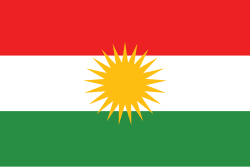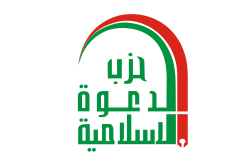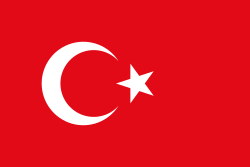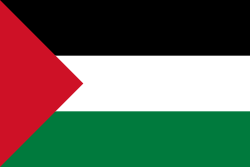Top Qs
Timeline
Chat
Perspective
Flag of Iraq
From Wikipedia, the free encyclopedia
Remove ads
Since the 1958 Iraqi coup d'état, the various republican governments of Iraq have used a number of different flags, all featuring the pan-Arab colors of green, black, white, and red. The current official and internationally recognized flag of Iraq (علم العراق) was adopted in 2008 as a temporary compromise, and consists of the three equal horizontal red, white, and black stripes of the Arab Liberation Flag, that was first used by Gamal Abdel Nasser during the Egyptian Revolution, with the takbīr written in green in the Kufic script that was originally added by Saddam Hussein following the Gulf War.
This basic tricolour has been in use since its adoption on 31 July 1963, with several changes to the green symbols on the central white stripe; the most recent version adopted on 22 January 2008[2] bears the takbīr rendered in dark green and removes the three green stars present since 1963.[2] The flag was initially meant to be temporary but has remained the official flag long past originally intended.[3]
Remove ads
Colour scheme
Valid for Iraqi flags 1963–present[4]
History
Summarize
Perspective
Iraq as part of the Abbasid Caliphate (750–1258)

The Abbasid Revolution against the Umayyad Caliphate adopted black for its rāyaʾ for which their partisans were called the musawwids.[5] Their rivals chose other colours in reaction; among these, forces loyal to Marwan II adopted red.[6] The choice of black as the colour of the Abbasid Revolution was already motivated by the "black standards out of Khorasan" tradition associated with the Mahdi. The contrast of white vs. black as the Fatimid vs. Abbasid dynastic colour over time developed in white as the colour of Shia Islam and black as the colour of Sunni Islam.[7] After the revolution, Islamic apocalyptic circles admitted that the Abbasid banners would be black but asserted that the Mahdi's standard would be black and larger.[8] Anti-Abbasid circles cursed "the black banners from the East", "first and last".[9]
Ottoman Iraq (1534–1920)
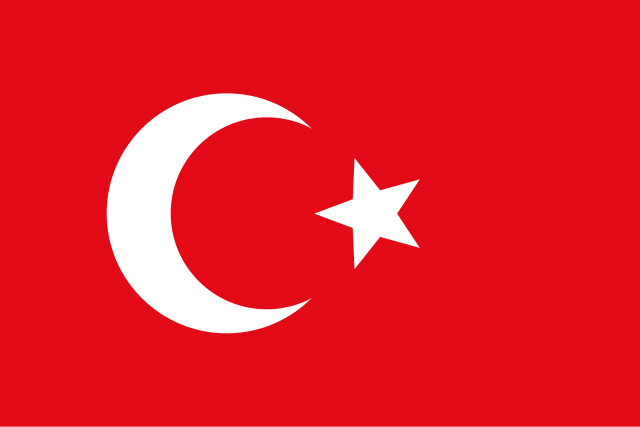
Starting in 1534, the territory that is now Iraq was administered by the Ottoman Empire. In 1844, the Ottoman Empire had adopted a national flag as part of the Tanzimat reforms, this flag was used in Iraq until the Arab Revolt, and inspired the flags of the modern Iraqi Turkmen.
Kingdom of Iraq (1921–1959)
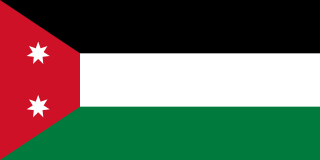
 10 July 1924 – 1 January 1959 (ratio: 1:2)
10 July 1924 – 1 January 1959 (ratio: 1:2)The first flag of modern Iraq was in Mandatory Iraq, and was adopted in 1921. It was a black-white-green horizontal flag, with a red triangle extending from the mast side, inspired by the flag of the Arab Revolt. It was soon changed to a new version with a red trapezoid replacing the triangle containing two, seven-point white stars denoting the Tigris River and the Euphrates River. Both designs also reflected the newly installed Hashemite dynasty in Iraq (originally from the Hejaz in the Arabian Peninsula), who had played a leading role in the Arab Revolt. As such, it was similar to the flags of Hashemite Jordan, and the short-lived Kingdom of Hejaz.[10][11] The new flag continued to be used in the Kingdom of Iraq.
Iraq as part of the Arab Federation (1958)

 23 August 1921 – 10 July 1924 (ratio: 1:2), reused as Flag of the Arab Federation, of which Iraq was part, January 1, 1958 – December 31, 1958
23 August 1921 – 10 July 1924 (ratio: 1:2), reused as Flag of the Arab Federation, of which Iraq was part, January 1, 1958 – December 31, 1958In 1958, in response to the merger of Egypt and Syria in the United Arab Republic, the two Hashemite kingdoms of Iraq and Jordan established the Arab Federation, a confederation of the two states. The flag of the union was essentially that of Jordan but without seven pointed star in the red chevron.[12] This flag is identical to the flag of Palestine adopted in 1964, and almost identical to the flag of the Ba'ath Party. The union lasted less than six months, being terminated by the Iraqi Revolution of 1958 in July.
Qasimist Iraq (1959–1963)

 January 1, 1959 – July 31, 1963 (ratio: 1:2)
January 1, 1959 – July 31, 1963 (ratio: 1:2)Following the Revolution of 14 July 1958, led by Abd al-Karim Qasim, which abolished the Hashemite monarchy in Iraq and turned the country into a republic, Iraq adopted a new flag (Law 102 of 1959) that consisted of a black-white-green vertical tricolour, with a red eight-pointed star with a yellow circle at its centre. The black, white, green, and red are the Pan-Arab colors, representing pan-Arabism, with the yellow Kurdish Sun in the middle to represent the Iraqi Kurds, surrounded by the red Star of Ishtar to represent the indigenous Assyrians.[13][14][15]
Ba'athist Iraq (1963–2004)
Iraq adopted a variation of the UAR's flag with a third star to represent Iraqi aspirations to join a new Arab Union
After the 1963 Ramadan Revolution led to the overthrow of Qasim, the new government adopted a new national flag to represent the Nasserist ideology endorsed by President Abdul Salam Arif, officially replacing the flag adopted by Qasim on July 31 of 1963 with Law 28 of 1963.
The Three-star flag is believed to have been originally designed and proposed by Jawad Saleem, a Turkish-born artist with origins in Mosul who also designed and sculpted the Freedom Monument in Baghdad, originally as a tribute to Qasim's revolution.[16] The horizontal red, white, and black tricolour was based on the United Arab Republic (UAR) flag, and featured three green stars symbolizing a desire to join a reunited Egypt and Syria.[17] Saleem died in 1961 before its official adoption.
In a move symbolising support for a reformed UAR, Ba'athist Syria also adopted this flag as its national flag with slightly different proportions until 1971, when it replaced the stars with the Hawk of Quraish due to its membership in the Federation of Arab Republics.[18]
During his rule, Saddam Hussein made two significant changes to the 1963 flag. First, he reinterpreted the three stars in the Flag Law No. 33 of 1986 to represent the Ba'ath Party's motto Waḥda, Ḥurriyya, Ishtirākiyya ("unity, freedom, and socialism"). Second, in 1991, amid the Gulf War and as a prelude to the Faith Campaign, he added the takbīr ("Allahu akbar") between the stars to gain religious support and emphasize Iraq's Islamic identity, moving away from the Ba'ath Party's traditional secular stance. The hamza over the alif of “Allah” in the main variant seems to be a spelling error according to formal Arabic grammar, but it is a common mistake found in many texts.[2] The form of the takbīr was said to be Saddam's own handwriting.[19] Despite this, the original 1963 flag without the takbīr remained legal and remained in co-official use until 2004, most commonly as a civil ensign or in places where a less religiously sensitive flag was needed, this contrasts the flag's use after 2012 as a symbol of Sunni Arab ethnic and religious affiliation. Following the 2003 invasion of Iraq, the three-star flag was used as a symbol of the Iraqi Insurgency with rebel groups even without direct Sunni identity or ideology such as the Sufi-led Naqshbandi Army and Shia Mahdi Army using versions of the flag as a shared symbol.

The 1963 flag reemerged during the 2012–2013 Iraqi protests, adopted by many Sunni Arabs as the distinctive ethnic flag to represent Iraqi Sunni Arabs as a whole and a reference to a time when Iraq was dominated by Sunni leadership and perceived as more favorable and secure for Sunnis. Its meaning shifted from a former national flag to one associated with Sunni Arab identity and political expression. Shias and other minority groups in Iraq today generally do not identify with the flag, viewing it primarily as a symbol of Sunni Arab identity and Ba'athist political legacy rather than a unifying national emblem, despite originally being an inherently non-sectarian symbol with Nasserist origins.[20][21]
2004–2008



 15 August 2004 – 22 January 2008 variant of the flag of Iraq with stylized Kufic script (ratio: 2:3)
15 August 2004 – 22 January 2008 variant of the flag of Iraq with stylized Kufic script (ratio: 2:3)
Owing to differing views on a flag proposed by the United States-appointed administration, and the prevailing opposition to an outright abandonment of the current Iraqi flag, a compromise measure was adopted by the U.S.-appointed Iraqi interim administration in 2004. The basic form of the existing flag was retained;[22] however, the takbīr was rendered in traditional stylized Kufic script, as opposed to the handwriting of Saddam Hussein.
The modified flag was unveiled at the ceremony marking the technical "handover" of power from the Coalition Provisional Authority occupation forces to the U.S.-appointed administration on 28 July 2004.[23]
Although the 2004 version of the Iraqi flag was introduced as a transitional design intended to reduce overt associations with Saddam Hussein's regime, the current Government of Iraq continues to regard all iterations of the three star flag featuring the takbir between the stars as symbols linked to Ba'athist rule. In March 2025, police in Baghdad arrested a resident of the Sumer district after he raised the 2004 flag over his home, reportedly citing it as an expression of allegiance to the former regime.[24]
2008–present

 22 January 2008[25] – present flag of Iraq (ratio: 2:3)
22 January 2008[25] – present flag of Iraq (ratio: 2:3)
On 22 January 2008,[25] the Council of Representatives of Iraq approved its new design for the national flag, confirmed by Law 9 of 2008 as the compromising temporary replacement for the Ba'athist Saddam-era flag. In this current version, the three stars were removed, leaving only the takbīr (which confused some Iraqis, as this was the part added to the flag directly by Saddam), with the two words of the takbīr being brought closer together and rendered in bold, and corrected the previous spelling of Allah (ألله to الله). The removal of the three stars was demanded by the Kurdish population of Iraq, who associated the three stars with the Al-Anfal genocide. But their removal provoked criticism among non-Kurdish Iraqis, mainly Iraqi Arabs, who argued that the stars did not represent the Ba'athist regime, and the city of Fallujah refused to fly the temporary flag that year unless instructed otherwise.[26] The parliament intended for the new design to last one year, after which a final decision on the flag would be made. However, the flag law was reviewed in parliament on 30 August 2009.[27]
Remove ads
Symbolism
The Iraqi flag consists of four colours: red, white, green and black, inspired by the poetic verse of Safi al-Din al-Hilli: "Our actions are bright, our battlefields are dark, our lands are green, and our swords are red with the blood of our enemies".[28]
Specifications

 22:January 2008 – present flag of Iraq (ratio: 2:3)
22:January 2008 – present flag of Iraq (ratio: 2:3)The flag is in the form of a rectangle, the width of which is two-thirds of its length, and it consists of three horizontal bands of equal dimensions, the top in red, the middle in white, and the bottom in black, and the words ʾAllāhu ʾakbar "الله اكبر" in Kufic script coloured green is in the middle of the middle white rectangle. The ratio of flag is 2:3.
Remove ads
Flag proposals and flag contest
Summarize
Perspective
2004 flag proposal and controversy
Following the military invasion of Iraq by the United States in 2003, the Iraqi government was overthrown, and the Ba'ath party was outlawed. Strong speculation followed that the U.S. government would press for a change in the Iraqi flag to remove its pan-Arab symbolism, and to make a definitive break with the period of Ba'athist rule. To a degree, this view was shared by some groups in Iraq. In addition to some displeasure among Iraqis who had suffered under Saddam Hussein to retaining national symbols used by his government, there was also strong aversion to the flag from Iraq's Kurdish minority, who resented its evocation of pan-Arabism. However, Iraqi opponents of changing the flag argued that since the flag had been used since 1963, long before Saddam Hussein's presidency, it was unfair to characterise it as a "Saddamist" flag. They also stressed that pan-Arabism has been a dominant popular principle among Iraqi's majority population for decades prior to Iraqi independence in 1932.
On 14 August 2004 the U.S.-appointed Iraqi Governing Council (IGC) announced a new flag during Saddam's Iraq. The IGC stated that, from around 30 competing entries, it had chosen a design by the distinguished Iraqi artist-architect Rifat Chadirji, who lived in London, and is a brother of a member of the IGC. Chadirji commented that the guidelines stipulated that Iraq should be portrayed as part of the Western world, with historical elements included. The simplicity of his design was inspired by the flags of Canada and Switzerland,[29] and it also shares elements (a crescent, stripes, a light blue shade) with the flag of his ethnic group, the Iraqi Turkmen.
The proposed flag had several meanings:[29]

 Proposed flag, 2004 (later abandoned) during American occupation.
Proposed flag, 2004 (later abandoned) during American occupation.The design marked a notable break with the three flags of modern Iraqi history (namely the Arab Revolt-inspired flag of the Kingdom, the flag introduced by Abd al-Karim Qasim, and the Arab Liberation inspired flag of 1963), all of which were based on the four Pan-Arab colours. Indeed, of these colours, only white was represented in the IGC design. Moreover, Islamic crescents are usually depicted in green or red in Arab heraldry. The proposed change provoked an intensely negative reaction across groups of Iraq's Arab majority, including those vehemently opposed to Saddam Hussein. Those opposed to the U.S. occupation, including Shi'a cleric Muqtada al-Sadr, decried the design as an attempt by the U.S. government to strip Iraq of its identity, and its historically prominent role in the Arab world. In particular, critics lamented the proposed abandonment of the Arab Liberation Flag, the omission of the traditional colours of pan-Arabism, and the removal of the takbīr.
Additionally, the new flag's predominantly blue-on-white appearance immediately antagonized many in Iraq because of the claim that it was similar to the flag of Israel.
The new flag was reported to have been burned by insurgents in Fallujah on 27 April 2004, the day before its planned official adoption. [citation needed]
On 28 April 2004, IGC President Masoud Barzani formally presented a modified version of the flag in which the originally very light shade of blue as reported by the press on 26 April 2004 had been changed to a darker tone. It was unclear whether this was a change made because of the protests made against the original design or, as the Council claimed, a rectification of printing errors in the earlier news reports. Barzani also explained that the flag was a temporary design, to be used over the ensuing months until the adoption of a definitive flag.
In the face of the overwhelming public outcry, adoption of the blue crescent flag was abandoned entirely.
2008 flag proposals
Despite the compromise in 2004, opposition to the flag persisted from Kurdish groups. In January 2008, a new design was proposed, removing the three green stars, instead placing a green eight pointed star around a yellow circle in the middle of the takbīr, which is written in the Kufic script and prized as a Mesopotamian Arabic style, having originated in Iraq.[30]
In July 2008, the Iraqi parliament launched a contest to design a new Iraqi flag. The contest ran until September 2008, with 50 designs submitted. Six designs were chosen and sent to the parliament which was to choose a new flag before the end of 2008.[31]
Another proposed design was also similar to the 2004–2008 flag, but the script was changed to yellow to represent the Kurdish people in northern Iraq. The meaning of the three stars would be changed to symbolize peace, tolerance and justice.[32]
Remove ads
Subnational flags
Summarize
Perspective
Minority ethnic flags
Governorates
Remove ads
Gallery
Military flags
Political/Rebel flags
Remove ads
See also
References
External links
Wikiwand - on
Seamless Wikipedia browsing. On steroids.
Remove ads










